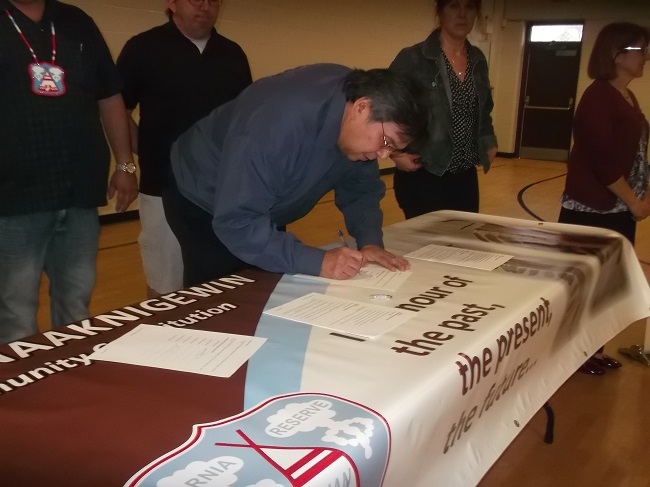Aamjiwnaang First Nation opens new chapter in its history

By Colin Graf
AAMJIWNAANG FIRST NATION—Aamjiwnaang First Nation is opening a new chapter in its history as it prepares for self-government by signing its Chi-Naaknigewin—the community constitution.
“No longer will we allow anyone to dictate to us how things will be done,” Chief Joanne Rogers told Aamjiwnaang members at the signing ceremony Apr. 11, at the local community centre.
The 10-page constitution will allow the southwestern Ontario community located next to the city of Sarnia, to “get from under the Indian Act,” and start making its own laws, Rogers told Anishinabek News in an interview.
Priorities for Council include creating Aamjiwnaang’s own election law, and writing environmental regulations for the community which is surrounded by the network of oil refineries and chemical plants known as Canada’s Chemical Valley.
Councilor Darren Henry, a member of the constitution development team told the meeting the idea of self-government has been discussed for over 20 years, and “in a sense, we are rebirthing ourselves as a nation” with the signing of the document.
Creating the community’s own laws will not be easy, according to Chief Rogers. Council is anxious to get started on the process of law-making, but “we need to tread slowly,” she warned.
“There’s the problem of who’s going to enforce those laws and prosecute violations; that is, if we can even get them into the court system,” she added.
“Do we need our own courts?” Rogers, a former Justice of the Peace, wondered.
Administrators may reach out for advice to First Nations in other parts of Canada, such as British Columbia, who are already writing their own legislation, she said.
“This is our part of the world. Our heart sounds from this place. Far too long we have allowed ourselves to be ruled by the Indian Act,” said Lynn Rosales, leader of a Water Ceremony held to honour the constitution-signing. A Pipe Ceremony was also held.
The Constitution describes the origins of Aamjiwnaang’s people as descendants of the Ojibwe, Potawatomi, and Odawa (The People of the Three Fires confederacy). It states that members will, “by the guidance of the Seven Grandfather Teachings and with dedicated leadership, strive to meet the needs of Aamjiwnaang in order to build a strong, safe, sustainable and healthy community for the benefit of present and future generations.”
The community’s Council will consist of a Chief and nine Councilors, and draft laws may be introduced at a regular Council meeting by a community member if it is signed by 40 or more supporters, by the Chief or a Councilor, or by a Council-appointed committee or board, according to the document. Laws can be approved by a simple majority of Council after it is posted publicly for 60 days and community input is received.
A working draft of the constitution was completed by a local team of eight community and council members last June, and was shared with the community through focus groups, community information sessions, and social media. The final draft was approved last October in a community vote, with 140 out of 153 votes in favour.
Creation of constitutions for various Anishinabek nations was originally prompted by a requirement of the Aboriginal Education System (AES).


